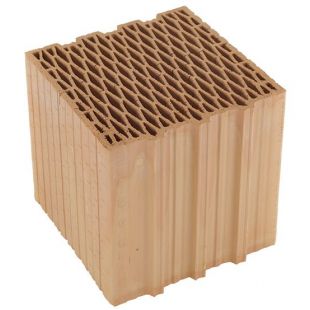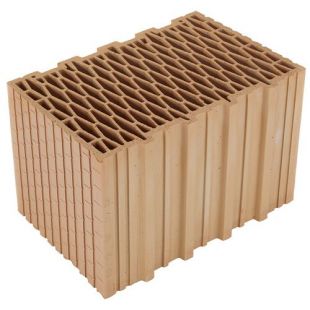- Construction technologies
- 5 likes
- 8428 views
Before every person who is planning to build a house, there is a logical question: what material to build a wall? ? Of brick, wood, gazoblokov or ceramic blocks
Let us consider two of the most popular material for the walls - it is aerated concrete blocks and ceramic blocks
. Ceramic blocks - is the wall material, which is made from environmentally friendly materials. For the production of ceramic blocks using natural clay, to which is added 20%wood chips, which are in the process of baking the blocks in furnaces at temperatures above 1000 degrees burn out, thereby obtaining a porous structure ceramic blocks.
Basic advantages walls of ceramic blocks:
1. ceramic blocks withstand the load of 100-150 kg per cm2, so one can construct bearing walls without additional base plates
2. . The wall of the ceramic blocks does not require reinforcement and embedded parts, therefore, savings in expensive metal.
3. Ceramic blocks have good water vapor permeability and high thermal capacity - the walls "breathe", accumulate heat and smooth out sudden changes in ambient temperature, i.e. supported by a favorable microclimate for the premises.
4. Ceramic blocks have a very good performance on sound insulation to 55dB.
5. Ceramic blocks have low moisture absorption, and hence high resistance to frost.
6. Ceramic blocks - incombustible material 4 have refractoriness chasa
7.. Ceramic blocks - it is 100%natural product
8.. Ceramic blocks plastered conventional cement or lime mixtures without additional reinforcement
Disadvantages ceramic blocks:.
The relatively high cost
<. em=""> aerated concrete, foam concrete
In the construction market there are several types of cellular concrete blocks , which is different technology for producing a porous structure - a foam . and aerated with autoclave and non-autoclave hardening
In Ukraine 90%of cellular concrete blocks - it is aerated autoclaved. For porization concrete raw mix for cellular concrete added blowing agent, usually an aluminum paste, powder. During mixing the aluminum reacts with the alkaline components of raw material with hydrogen. This gas forms a porous structure and material.
Specifications
concrete blocks strength of the material 20 - 30 kg / cm2 , depending on the density.
Thermal conductivity 0,12 W / (m ∙ K) dry-lab. < / p>
Thermal conductivity 0,14 - 0,16 W / (m ∙ K) in a state of operation - the actual.
Frost F25 .
Moisture absorption 25-30%.
Advantages
- The low price (the main advantage)
- < span> Low thermal conductivity, but a large difference between the values in the dry state and operational.
- It is easy to machine.
The disadvantages of concrete blocks: < / span>
Aerated concrete is an artificial material that is made of reactive substances!
- The low strength of the material and laying 5 - 8 kg / cm² .
- high moisture content - more 25 % from the factory. Long drying gazoblokov makes heat-conducting walls.
- Undergoes the phenomenon of carbonation.
- Large material shrinkage during drying, leading to the formation of cracks.
- The low sound insulation.
- Shallow heat of the material does not contribute to heat accumulation within the walls. < / li>
- Low fire walls.
- For the adhesion of plaster to the surface of the aerated concrete wall requires special plaster.
The main drawbacks of concrete blocks - is a low strength and chemical carbonization process that is constantly happening in aircrete
If the concept of strength clear to all that! of carbonation know very little
carbonation -. it is a constant chemical reaction within the concrete blocks , which resulted in the pores of aerated concrete calcium hydroxide reacts with carbon dioxide and forms calcium and water Ca ( OH < span>) 2 + CO 2 = CaCO 3 + H 2 O . < / span>

Carbon dioxide contained in the atmosphere, in the presence of moisture, can react with the cement stone and minerals. This reaction occurs at very low concentrations of CO 2 - sufficient to react the partial pressure of carbon dioxide vapor 3 * 10 -5 < span> MPa (in an unventilated room vapor pressure of carbon dioxide may be 12 * 10 -5 MPa). carbonation acts primarily on silicates and aluminates, which make up the aerated concrete blocks, resulting in the formation of various types of calcium carbonate and ettringite!
carbonation reaction in the cellular concrete proceeds much more intensively than in the concrete of the heavy, this is because the gas permeability of porous concrete is much higher gas permeability of heavy concrete. So according to VM Moskvin carbonation rate of dense concrete ... 1 3 mm per year, and under the same conditions at the cellular concrete 10 ... 20 mm per year.
Other words within the pores continuously aerated and calcium crystals grow quickly and water is formed.
How bad is it?
First, the moisture reduces the thermal resistance of the walls, the house does not become so warm as in theory.
Vo Secondly, calcium reduces the strength of the walls 20-50%.
And after all this, you still want to live in a house made of cellular concrete?!





